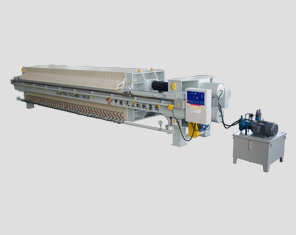Diaphragm filter press conventional drainage method
Diaphragm filter presses are widely used in mining, light industry, chemical industry and other industries due to their low water content in the filter cake. During the entire filter press process, the filtrate needs to be discharged from the equipment. Therefore, for filter presses, rapid drainage is the The key to work efficiency, especially in the feed filtration stage, needs to quickly discharge a large amount of filtrate, and the material has a great impact on the filter cloth and filter plate. Most filter cloth damage and filtrate turbidity often occur in this stage. And filter cloth damage , it will cause the filtrate to be turbid during the whole pressure filtration process, resulting in the escape of a large number of materials and the high solid content of the filtrate. In severe cases, it will even lead to the failure of the pressure filtration, which will seriously affect the work efficiency, increase labor intensity, and cause serious environmental pollution. In the workshop where the filtrate discharge system is transformed by turbidity separation, the working efficiency of the system will be greatly reduced. If the clean water valve and the turbid water valve of the system are switched according to the feeding time, a large amount of filtrate will be mixed into the clean water pipeline and then flow into the circulating water system, causing a lot of unnecessary Trouble.
Therefore, ensuring smooth and fast drainage and reducing the number of inefficient and ineffective filtration has become an important way to improve the working efficiency of the filter press, which mainly depends on the integrity of the filter cloth, drainage methods and manual operations.
Diaphragm filter press
The drainage method of the filter press is generally divided into open flow, undercurrent and bright and dark flow. Open flow refers to the way in which the filtrate is directly discharged from the side of the filter plate, and undercurrent refers to the filtrate collected in the channel composed of several corner holes of the filter plate. The method of discharge. Most of the diaphragm filter presses used in mines will use open flow and undercurrent to discharge at the same time, or open flow discharge, and only in special circumstances will the undercurrent discharge be separated.
The open-flow straight discharge pipe may not be provided with corner holes, and the filtrate is discharged directly from the discharge surface → discharge port → integrated hole → open-flow pipe. The entire equipment only has open-flow discharge, and it is necessary to install a valve on the straight discharge pipe according to actual needs. Valves are generally not installed when used. In addition, when used in some occasions, straight pipes are not installed, but the integrated holes are directly punched down through the filter plate to form an open orifice, and the filtrate is received by the liquid collecting plate, such as some metal mines and Some filter presses for the chemical industry.
The common open and dark flow drainage pipe is to install the drainage pipe at the open flow outlet, and install the valve on the pipe as needed. If there is a valve, the valve only controls the open flow drainage, and cannot control the liquid in the corner hole. At this time, if the filtrate is turbid, Even if the open flow pipe valve of the filter plate is closed, the turbid filtrate on the drainage surface of the filter plate will continue to flow into the corner hole from the integral hole, and flow out from the drainage pipe or undercurrent of other filter plates, resulting in a high solid content of the filtrate. Most of the drainage methods are of this type.
Diaphragm filter press
Most of the fully submerged drainage directly blocks the open orifice, so that the filtrate is discharged from the submerged flow tube composed of angular holes. This method is mostly used in fine chemicals, pharmaceuticals, hydrometallurgy and other occasions where the filter cake needs to be washed, and in the coal preparation industry Almost never used.

Related Industry Knowledge
- Daily maintenance and maintenance of vertical presses
- Application scope and characteristics of soy sauce press
- Principle of diatomite filter and maintenance guide of filter lubrication system
- The understanding of the nominal flow of the filter and its application
- Diaphragm filter press hydraulic device adopts double cylinder and screw extension structure
- Rice wine press by maintenance and preventive measures
- Daily maintenance and maintenance of plate and frame filter press
- Features of automatic filter press
- Diatomite filter operation method and application
- Working principle and characteristics of stainless steel press
- Material filtration method of plate and frame filter press
- How to use the rice wine press accurately
- Features of automatic filter press
- Function introduction of each component of filter press
- The working principle of plate and frame filter press
- Importance of filter press manufacturers in water treatment
- Analysis of why the pressure of automatic filter press fails
- What is the filtering principle of the filter
- How to Improve the Working Efficiency of the Plate and Frame Filter Plate of the Filter Press
- What should I do if the pressure of the filter press is not enough?


